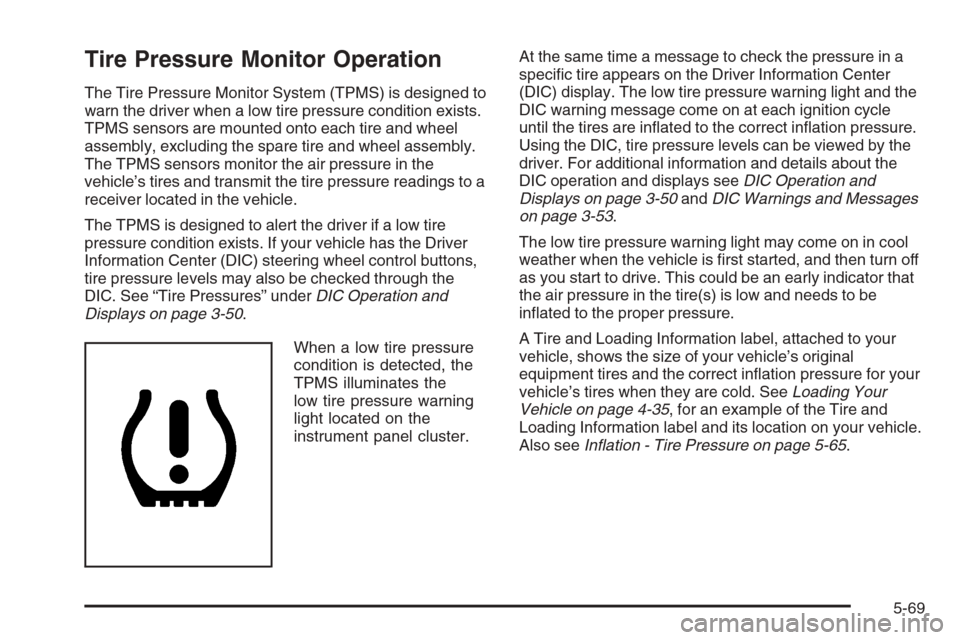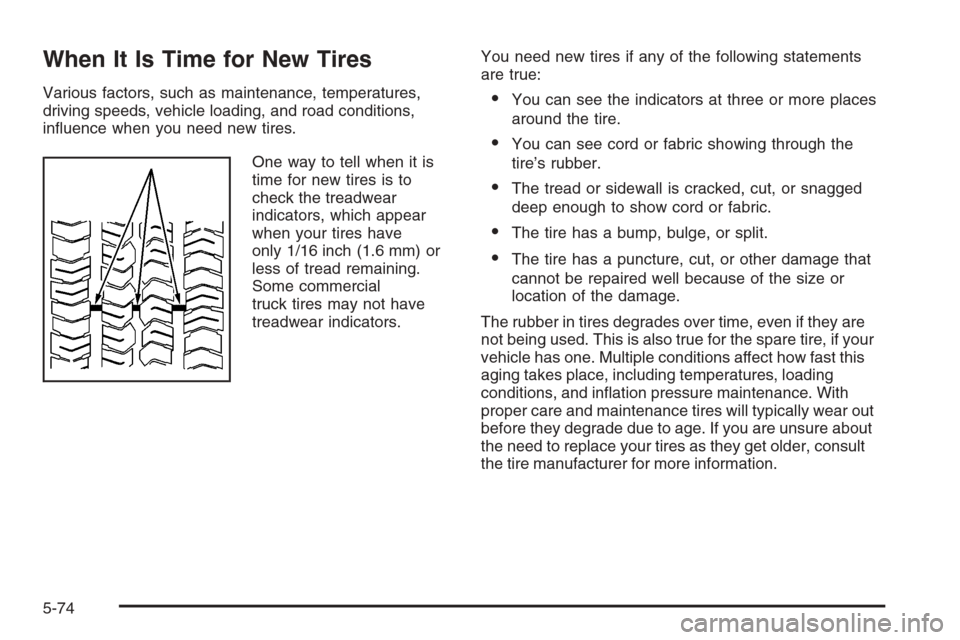Page 367 of 472

Tire Pressure Monitor Operation
The Tire Pressure Monitor System (TPMS) is designed to
warn the driver when a low tire pressure condition exists.
TPMS sensors are mounted onto each tire and wheel
assembly, excluding the spare tire and wheel assembly.
The TPMS sensors monitor the air pressure in the
vehicle’s tires and transmit the tire pressure readings to a
receiver located in the vehicle.
The TPMS is designed to alert the driver if a low tire
pressure condition exists. If your vehicle has the Driver
Information Center (DIC) steering wheel control buttons,
tire pressure levels may also be checked through the
DIC. See “Tire Pressures” underDIC Operation and
Displays on page 3-50.
When a low tire pressure
condition is detected, the
TPMS illuminates the
low tire pressure warning
light located on the
instrument panel cluster.At the same time a message to check the pressure in a
speci�c tire appears on the Driver Information Center
(DIC) display. The low tire pressure warning light and the
DIC warning message come on at each ignition cycle
until the tires are in�ated to the correct in�ation pressure.
Using the DIC, tire pressure levels can be viewed by the
driver. For additional information and details about the
DIC operation and displays seeDIC Operation and
Displays on page 3-50andDIC Warnings and Messages
on page 3-53.
The low tire pressure warning light may come on in cool
weather when the vehicle is �rst started, and then turn off
as you start to drive. This could be an early indicator that
the air pressure in the tire(s) is low and needs to be
in�ated to the proper pressure.
A Tire and Loading Information label, attached to your
vehicle, shows the size of your vehicle’s original
equipment tires and the correct in�ation pressure for your
vehicle’s tires when they are cold. SeeLoading Your
Vehicle on page 4-35, for an example of the Tire and
Loading Information label and its location on your vehicle.
Also seeInflation - Tire Pressure on page 5-65.
5-69
Page 372 of 472

When It Is Time for New Tires
Various factors, such as maintenance, temperatures,
driving speeds, vehicle loading, and road conditions,
in�uence when you need new tires.
One way to tell when it is
time for new tires is to
check the treadwear
indicators, which appear
when your tires have
only 1/16 inch (1.6 mm) or
less of tread remaining.
Some commercial
truck tires may not have
treadwear indicators.You need new tires if any of the following statements
are true:You can see the indicators at three or more places
around the tire.
You can see cord or fabric showing through the
tire’s rubber.
The tread or sidewall is cracked, cut, or snagged
deep enough to show cord or fabric.
The tire has a bump, bulge, or split.
The tire has a puncture, cut, or other damage that
cannot be repaired well because of the size or
location of the damage.
The rubber in tires degrades over time, even if they are
not being used. This is also true for the spare tire, if your
vehicle has one. Multiple conditions affect how fast this
aging takes place, including temperatures, loading
conditions, and in�ation pressure maintenance. With
proper care and maintenance tires will typically wear out
before they degrade due to age. If you are unsure about
the need to replace your tires as they get older, consult
the tire manufacturer for more information.
5-74
Page 388 of 472
6. Place the jack in the appropriate position nearest
the �at tire.
{CAUTION:
Getting under a vehicle when it is jacked up is
dangerous. If the vehicle slips off the jack, you
could be badly injured or killed. Never get under
a vehicle when it is supported only by a jack.
{CAUTION:
Raising your vehicle with the jack improperly
positioned can damage the vehicle and even
make the vehicle fall. To help avoid personal
injury and vehicle damage, be sure to �t the
jack lift head into the proper location before
raising the vehicle.7. Raise the vehicle by turning the jack handle
clockwise. Raise the vehicle far enough off the
ground so there is enough room for the spare
tire to �t.
5-90
Page 396 of 472
A. Wheel Wrench
B. Hoist Shaft
C. Extension
D. Retainer
E. Spare or Flat
Tire (Valve Stem
Pointed Up)
1. Put the tire (E) on the ground at the rear of the
vehicle.
2. Remove the hubcap, if the vehicle has one, from
the �at tire by tapping the backside of the hubcap
with the wheel wrench (A). Store in a safe location
until the �at tire is repaired. Once the tire is
repaired, replace the hubcap.3. Make sure the valve stem is pointed up and to
the rear.
4. Pull the retainer (D) through the wheel.
5. Put the socket end of the extension (C) through the
hole just above the rear bumper at a 45 degree
angle downward. Connect the socket end of
the extension to the hoist shaft (B).
6. Raise the tire fully against the underside of the
vehicle. Continue turning the wheel wrench (A)
clockwise until you hear two clicks or feel it
skip twice. This indicates that the tire is secure and
the cable is tight. The spare tire hoist cannot be
overtightened.
5-98